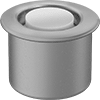Filter by
Ball Material
OD
ID
Ring Material
DFARS Specialty Metals
Housing Material
Bearing Material
Washer Material
Shell Material
Carriage Material
Ball Stud Material
Ball Bearing Profile
Power Transmission
Fabricating and Machining
Material Handling
Fastening and Joining
Raw Materials
Building and Machinery Hardware



















































































